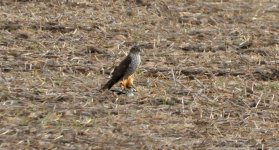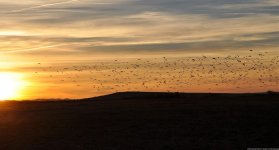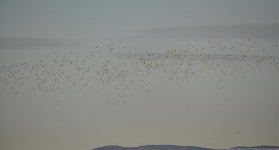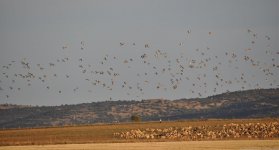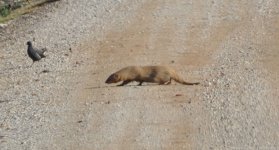vicente malagon
Well-known member
Last December I started at ABS Forum (Andalucia Bird Society http://www.andaluciabirdsociety.org/ ) a serial of reports about the most interesting sightings in my local patch, La Mancha & Sierra Morena.
Too much work in these large months of 2013 has prevented me to continue with that serie of reports, but now I think that I’ll have time for show the rich birdlife of my area.
I’d also like to share this “short” reports with you in the BIRD FORUM, though you could find them in the ABS FORUM .
This is a very short resumé of the first 9 months of the year:
Jan. 01 – Tablas de Daimiel N.P.: Black Shouldered Kite (rare here) and a couple of Stock Dove.
Jan. 26 – Daimiel surroundings: 3 Egyptian Geese, a flock of over 300 Little Bustards plus dozens of Pin-Tailed Sandgrouse, over 30 Stone Curlews and more than 300 Golden Plovers.
Jan. 26 – Almagro Fields: 20 Pin-Tailed Sandgrouse grazing in a an area close to a Great Bustard territory (watched 108 GB this day), and a albino individual of Crested Lark.
Jan. 29 – Sierra de Andujar: 2 Spanish Imperial Eagle plus a plethora of common birds here such as Black Vulture, Golden Eagle, Blue Rock Thrush, Dartford Warbler, etc.
Feb. 3 – Guadiana River: 1 solitaire Barn Swallow.
Feb. 3 – Tablas de Daimiel N.P.: 3 Goldcrest.
Feb. 16 – Campo de Calatrava: 2 Golden Eagle, 2 Spanish Imperial Eagle, a flock of over 12 Hawfinch and a rare Willow Warbler in this period of the year, this bird seen and heard.
Feb. 17 – Almagro: 4 Spanish Imperial Eagle (included an adult female) and our first Great Spotted Cuckoo of the year.
Feb. 24 – Tablas de Daimiel N.P.: 2 big flocks of Black Kite moving north, with more than 340 individuals.
Mar. 2 – Tablas de Daimiel N.P.: 1 beautiful male of Bluethroat (a wintering bird here), still 8 Reed Buntings, and our first Moustached Warbler singing in the reeds.
Mar. 3 – Campo de Calatrava (Granatula): 1 Black Wheatear in a new location of the area.
Mar. 10 – Almagro (Jabalon river): 1 inmature Egyptian Vulture (first record in this area with more than 200 different species watched in 7 years of census), 6 Lesser Kestrel in their habitual breeding colony, 1 Turtle Dove and 1 Wryneck (another first record for this part of Almagro).
Mar. 15 – Tablas de Daimiel N.P.: a couple of Great Crested Grebe in their coutship (usually in February, but this year very late), 7 Glossy Ibis, 2 Water Rail watched crossing the reeds, 1 Savi’s Warbler, 1 Moustached Warbler, 1 Penduline Tit and still 2 Bluethroats, 5 Reed Buntings and 13 Common Cranes.
Mar. 19 – Tablas de Daimiel N.P.: 1 Marbled Duck, 1 Osprey and the first Woodchat Shrike of the season.
Mar. 21 – Tablas de Daimiel N.P.: 1 Garganey (male), the fisrt Short Toed Eagle of a very poor year in raptor sightings, several Moustached & Savi’s Warblers, and still some wintering birds here such as Blackcap or Water Pipit.
Mar. 23 – Campo de Calatrava (Jabalon river): A new Osprey on migration.
Mar. 24 – Tablas de Daimiel N.P.: Another Osprey, a second year Spanish Imperial Eagle, one Nightingale, flocks of Yellow Wagtails and besides them a laggard Merlin.
Mar. 28 – Tablas de Daimiel N.P.: First small flocks of Collared Pratincoles.
Mar. 29 - Tablas de Daimiel N.P.: 6 Marbled Ducks.
Mar. 30 - Tablas de Daimiel N.P.: 2 Purple Herons & 3 Spoonbills.
Abr. 3 – Campo de Calatrava (SPA Calatrava Steppes): among other common birds in the steppes, 42 Great Bustards, 12 Litte Bustards, 5 Montagu’s Harriers, 25 PT Sandgrouse, 16 BB Sandgrouse and 6 Short-Toed Lark.
Abr. 6 - Tablas de Daimiel surroundings: over 50 White Headed Ducks, 1 Redstart and 1 Bonelli’s Warbler.
Abr. 6 – Almagro: 77 Great Bustards, 300 Greater Flamingoes and my first record of WH Duck in my town.
Abr. 7 - Tablas de Daimiel N.P.: A Spotted Crake in the surroundings of the park (Zacatena Dehesa).
Abr. 13 – Campo de Calatrava (several locations in the volcanic area and the Guadiana river): 4 Black Storks, 50 Great Bustards, 1 Winchat and 1 Whitethroat, first Golden Oriole and first 8 Bee-Eaters. The most beautiful sighting this day was a stunning Osprey hovering in the Guadiana river for several seconds under the astonishing eyes of our customers.
Abr. 14 - Tablas de Daimiel N.P.: 2 Ferruginous Pochards, 3 WH Ducks, 1 Purple Swamphen, several Pied Flycatchers on migration and the very rare and localized Reed Bunting (whitherby supspecies) with one couple finally watched for our USA customer.
Abr. 16 – Cabañeros N.P.: 1 Purple Heron, a very rare bird in this special area for raptors.
Abr. 18 – Campo de Calatrava (SPA Calatrava Steppes): an amazing day, with the common species of this area plus Gull-Billed Tern, Black Vulture and 3 Spanish Imperial Eagles.
Abr. 19 - Tablas de Daimiel N.P.: 44 Collared Pratincoles and the fisrt Roller of the season.
Abr. 25 – Campo de Calatrava (SPA Calatrava Steppes): 1 Short-Eared Owl seen hawking two hours before dusk.
Abr. 27 - Tablas de Daimiel N.P.: 1 Hobby on migration.
May 10 - Tablas de Daimiel N.P.: 1 Western Reef Heron x Little Egret watched in the ABS Field Meeting of May (clearly identified by Peter Jones). A total of 94 species watched this day.
May 11 – Valle de Alcudia Natural Park: 2 Black Storks and several Hawfinchs.
May 18 – Campo de Calatrava (Moral): 5 WH Ducks.
Jun. 23 – Tablas de Daimel N.P.: At least 4 nests of Spoonbill inside the National Park, this is the second year that this bird breeds in the park. Several Little Bitterns seen flying plus a solitaire Little Tern in the surroundings. A couple of Long-Eared Owl was watched in the Tamarisk trees of “Isla del Pan” two hours before dusk.
Jun. 24 - Tablas de Daimel N.P.: a Honey Buzzard was seen for several days in the surroundings of the park, a very rare sight of a bird that doesn’t breed in the area. This day more than 6 Cuckoos were found in the Dehesa Zacatena, and our first record of Azure-Winged Magpie near the park (a bird that is fairly common outside).
Jul. 20 – Almagro (Volcanic Fields & Wetlands): 1 Little Bittern, 1 Squacco Heron, 25 Lesser Kestrel, over 20 Stone Curlew & 8 Pin-Tailed Sandgrouse, Red-Neck Nightjar, Kingfisher…
Jul. 21 - Tablas de Daimel N.P.: a Peregrine Falcon scaring all birds plus a solitaire and very difficult to see Sedge Warbler (start signal for the Autumn migration).
Jul. 27 - Tablas de Daimel N.P.: Spanish Imperial Eagle over the Guadina river. First Black-Tailed Godwitt.
Ago. 13 – Lagunas de Ruidera Natural Park: over 30 Black Kites on migration moving south, Little Bittern, Purple Heron and a couple of Whimbrels flying very fast towards the La Mancha plains.
Ago. 27 – Campo de Calatrava: Bonelli’s Eagle in the beautiful Fresneda river Gorge, plus the very common in the area Golden Oriole, Hawfinch, Rock Bunting, Blue-Rock Thrush… and our first Spotted Flycatcher of the Autumn migration.
Ago. 31 - Tablas de Daimel N.P.: the Honey Buzzard is seen again in the area. Many birds on migration, like Flycatchers, Redstarts and the really uncommon Wood Warbler.
Sep. 1 – Almagro (Volcanic Fields): a plethora of raptors in just a couple of hours, including Black & Griffon Vultures, Golden, Spanish & Bonelli’s Eagle, Sparrowhawk… but for us the most impressive view of the day was the sight of hundreds of Flamingoes in a volcanic lagoon inside the mountains, an unusual picture in this isolated and unknown area of La Mancha.
Sep. 7 – Almagro (Volcanic Fields): in the same area that the previous report, among the common big raptors of the area, a very white Short-Toed Eagle was seen perched over a Holm Oak near the water.
Sept. 7 - Tablas de Daimel N.P.: first Osprey on migration. The next day a Wryneck was observed inside the park.
Sept. 14 - Tablas de Daimel N.P.: Osprey and a couple of marvelous Beard Tit coming to roost in the reeds.
Sept. 15 - Tablas de Daimel N.P.: Osprey again, but also juv Little Bittern, Melodious Warbler, Squacco Heron…
Sept. 15 – Campo de Calatrava: 12 Black Stork, several of them juveniles.
Sept. 17 - Tablas de Daimel N.P.: 3 Marbled Ducks among several Red Crested Pochards, WH Ducks, etc.
Sept. 18 - Tablas de Daimel N.P.: 1 Ferruginous Pochard, 3 WH Duck, 1 Purple Swamphen and 1 Osprey. The same day, in Cabaneros N.P., several Winchat, 2 Red-Neck Nightjar and 1 RT Rock Thrush (second record of this bird inside the National Park).
Sept. 20 - Tablas de Daimel N.P.: a juvenile Goshawk chased by a big flock of Starlings that finally expel it out of the park.
Sept. 22 - Tablas de Daimel N.P.: a memorable afternoon inside the park: Bearded & Penduline Tits, 3 Bluethroats, Garden, Cetti’s, Bonelli’s & Melodious Warblers, Water Rail, Red-Neck Nightjar, WH Duck, 2 Marbled Ducks…
And this is all. A long report, I know, but I’ll try the next ones to be month by month.
Vicente.
Too much work in these large months of 2013 has prevented me to continue with that serie of reports, but now I think that I’ll have time for show the rich birdlife of my area.
I’d also like to share this “short” reports with you in the BIRD FORUM, though you could find them in the ABS FORUM .
This is a very short resumé of the first 9 months of the year:
Jan. 01 – Tablas de Daimiel N.P.: Black Shouldered Kite (rare here) and a couple of Stock Dove.
Jan. 26 – Daimiel surroundings: 3 Egyptian Geese, a flock of over 300 Little Bustards plus dozens of Pin-Tailed Sandgrouse, over 30 Stone Curlews and more than 300 Golden Plovers.
Jan. 26 – Almagro Fields: 20 Pin-Tailed Sandgrouse grazing in a an area close to a Great Bustard territory (watched 108 GB this day), and a albino individual of Crested Lark.
Jan. 29 – Sierra de Andujar: 2 Spanish Imperial Eagle plus a plethora of common birds here such as Black Vulture, Golden Eagle, Blue Rock Thrush, Dartford Warbler, etc.
Feb. 3 – Guadiana River: 1 solitaire Barn Swallow.
Feb. 3 – Tablas de Daimiel N.P.: 3 Goldcrest.
Feb. 16 – Campo de Calatrava: 2 Golden Eagle, 2 Spanish Imperial Eagle, a flock of over 12 Hawfinch and a rare Willow Warbler in this period of the year, this bird seen and heard.
Feb. 17 – Almagro: 4 Spanish Imperial Eagle (included an adult female) and our first Great Spotted Cuckoo of the year.
Feb. 24 – Tablas de Daimiel N.P.: 2 big flocks of Black Kite moving north, with more than 340 individuals.
Mar. 2 – Tablas de Daimiel N.P.: 1 beautiful male of Bluethroat (a wintering bird here), still 8 Reed Buntings, and our first Moustached Warbler singing in the reeds.
Mar. 3 – Campo de Calatrava (Granatula): 1 Black Wheatear in a new location of the area.
Mar. 10 – Almagro (Jabalon river): 1 inmature Egyptian Vulture (first record in this area with more than 200 different species watched in 7 years of census), 6 Lesser Kestrel in their habitual breeding colony, 1 Turtle Dove and 1 Wryneck (another first record for this part of Almagro).
Mar. 15 – Tablas de Daimiel N.P.: a couple of Great Crested Grebe in their coutship (usually in February, but this year very late), 7 Glossy Ibis, 2 Water Rail watched crossing the reeds, 1 Savi’s Warbler, 1 Moustached Warbler, 1 Penduline Tit and still 2 Bluethroats, 5 Reed Buntings and 13 Common Cranes.
Mar. 19 – Tablas de Daimiel N.P.: 1 Marbled Duck, 1 Osprey and the first Woodchat Shrike of the season.
Mar. 21 – Tablas de Daimiel N.P.: 1 Garganey (male), the fisrt Short Toed Eagle of a very poor year in raptor sightings, several Moustached & Savi’s Warblers, and still some wintering birds here such as Blackcap or Water Pipit.
Mar. 23 – Campo de Calatrava (Jabalon river): A new Osprey on migration.
Mar. 24 – Tablas de Daimiel N.P.: Another Osprey, a second year Spanish Imperial Eagle, one Nightingale, flocks of Yellow Wagtails and besides them a laggard Merlin.
Mar. 28 – Tablas de Daimiel N.P.: First small flocks of Collared Pratincoles.
Mar. 29 - Tablas de Daimiel N.P.: 6 Marbled Ducks.
Mar. 30 - Tablas de Daimiel N.P.: 2 Purple Herons & 3 Spoonbills.
Abr. 3 – Campo de Calatrava (SPA Calatrava Steppes): among other common birds in the steppes, 42 Great Bustards, 12 Litte Bustards, 5 Montagu’s Harriers, 25 PT Sandgrouse, 16 BB Sandgrouse and 6 Short-Toed Lark.
Abr. 6 - Tablas de Daimiel surroundings: over 50 White Headed Ducks, 1 Redstart and 1 Bonelli’s Warbler.
Abr. 6 – Almagro: 77 Great Bustards, 300 Greater Flamingoes and my first record of WH Duck in my town.
Abr. 7 - Tablas de Daimiel N.P.: A Spotted Crake in the surroundings of the park (Zacatena Dehesa).
Abr. 13 – Campo de Calatrava (several locations in the volcanic area and the Guadiana river): 4 Black Storks, 50 Great Bustards, 1 Winchat and 1 Whitethroat, first Golden Oriole and first 8 Bee-Eaters. The most beautiful sighting this day was a stunning Osprey hovering in the Guadiana river for several seconds under the astonishing eyes of our customers.
Abr. 14 - Tablas de Daimiel N.P.: 2 Ferruginous Pochards, 3 WH Ducks, 1 Purple Swamphen, several Pied Flycatchers on migration and the very rare and localized Reed Bunting (whitherby supspecies) with one couple finally watched for our USA customer.
Abr. 16 – Cabañeros N.P.: 1 Purple Heron, a very rare bird in this special area for raptors.
Abr. 18 – Campo de Calatrava (SPA Calatrava Steppes): an amazing day, with the common species of this area plus Gull-Billed Tern, Black Vulture and 3 Spanish Imperial Eagles.
Abr. 19 - Tablas de Daimiel N.P.: 44 Collared Pratincoles and the fisrt Roller of the season.
Abr. 25 – Campo de Calatrava (SPA Calatrava Steppes): 1 Short-Eared Owl seen hawking two hours before dusk.
Abr. 27 - Tablas de Daimiel N.P.: 1 Hobby on migration.
May 10 - Tablas de Daimiel N.P.: 1 Western Reef Heron x Little Egret watched in the ABS Field Meeting of May (clearly identified by Peter Jones). A total of 94 species watched this day.
May 11 – Valle de Alcudia Natural Park: 2 Black Storks and several Hawfinchs.
May 18 – Campo de Calatrava (Moral): 5 WH Ducks.
Jun. 23 – Tablas de Daimel N.P.: At least 4 nests of Spoonbill inside the National Park, this is the second year that this bird breeds in the park. Several Little Bitterns seen flying plus a solitaire Little Tern in the surroundings. A couple of Long-Eared Owl was watched in the Tamarisk trees of “Isla del Pan” two hours before dusk.
Jun. 24 - Tablas de Daimel N.P.: a Honey Buzzard was seen for several days in the surroundings of the park, a very rare sight of a bird that doesn’t breed in the area. This day more than 6 Cuckoos were found in the Dehesa Zacatena, and our first record of Azure-Winged Magpie near the park (a bird that is fairly common outside).
Jul. 20 – Almagro (Volcanic Fields & Wetlands): 1 Little Bittern, 1 Squacco Heron, 25 Lesser Kestrel, over 20 Stone Curlew & 8 Pin-Tailed Sandgrouse, Red-Neck Nightjar, Kingfisher…
Jul. 21 - Tablas de Daimel N.P.: a Peregrine Falcon scaring all birds plus a solitaire and very difficult to see Sedge Warbler (start signal for the Autumn migration).
Jul. 27 - Tablas de Daimel N.P.: Spanish Imperial Eagle over the Guadina river. First Black-Tailed Godwitt.
Ago. 13 – Lagunas de Ruidera Natural Park: over 30 Black Kites on migration moving south, Little Bittern, Purple Heron and a couple of Whimbrels flying very fast towards the La Mancha plains.
Ago. 27 – Campo de Calatrava: Bonelli’s Eagle in the beautiful Fresneda river Gorge, plus the very common in the area Golden Oriole, Hawfinch, Rock Bunting, Blue-Rock Thrush… and our first Spotted Flycatcher of the Autumn migration.
Ago. 31 - Tablas de Daimel N.P.: the Honey Buzzard is seen again in the area. Many birds on migration, like Flycatchers, Redstarts and the really uncommon Wood Warbler.
Sep. 1 – Almagro (Volcanic Fields): a plethora of raptors in just a couple of hours, including Black & Griffon Vultures, Golden, Spanish & Bonelli’s Eagle, Sparrowhawk… but for us the most impressive view of the day was the sight of hundreds of Flamingoes in a volcanic lagoon inside the mountains, an unusual picture in this isolated and unknown area of La Mancha.
Sep. 7 – Almagro (Volcanic Fields): in the same area that the previous report, among the common big raptors of the area, a very white Short-Toed Eagle was seen perched over a Holm Oak near the water.
Sept. 7 - Tablas de Daimel N.P.: first Osprey on migration. The next day a Wryneck was observed inside the park.
Sept. 14 - Tablas de Daimel N.P.: Osprey and a couple of marvelous Beard Tit coming to roost in the reeds.
Sept. 15 - Tablas de Daimel N.P.: Osprey again, but also juv Little Bittern, Melodious Warbler, Squacco Heron…
Sept. 15 – Campo de Calatrava: 12 Black Stork, several of them juveniles.
Sept. 17 - Tablas de Daimel N.P.: 3 Marbled Ducks among several Red Crested Pochards, WH Ducks, etc.
Sept. 18 - Tablas de Daimel N.P.: 1 Ferruginous Pochard, 3 WH Duck, 1 Purple Swamphen and 1 Osprey. The same day, in Cabaneros N.P., several Winchat, 2 Red-Neck Nightjar and 1 RT Rock Thrush (second record of this bird inside the National Park).
Sept. 20 - Tablas de Daimel N.P.: a juvenile Goshawk chased by a big flock of Starlings that finally expel it out of the park.
Sept. 22 - Tablas de Daimel N.P.: a memorable afternoon inside the park: Bearded & Penduline Tits, 3 Bluethroats, Garden, Cetti’s, Bonelli’s & Melodious Warblers, Water Rail, Red-Neck Nightjar, WH Duck, 2 Marbled Ducks…
And this is all. A long report, I know, but I’ll try the next ones to be month by month.
Vicente.




